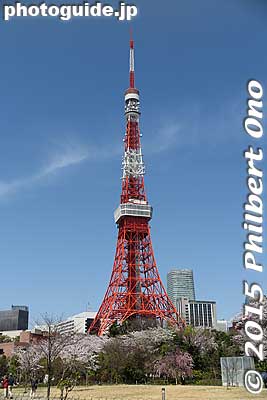One of Tokyo’s most famous Buddhist temples, Zojoji (増上寺) is a major temple in the Shiba area of Minato Ward, Tokyo. It belongs to the Jodo-shu Pure Land sect (headquartered at Chion-in Temple in Kyoto).
Soon after it moved to its present site in 1598, Zojoji became the Tokugawa shogun’s family temple. A family temple is where family members are buried and periodic Buddhist prayers are held for them. With the Tokugawa being Japan’s most prominent clan during the Edo Period (1603–1868), their two family temples, Zojoji and Kan’eiji, were greatly expanded. They built grand mausoleums for themselves similar to the one in Nikko (Tochigi Prefecture) for Ieyasu, the first Tokugawa shogun. Six Tokugawa shoguns (Hidetada, Ienobu, Ietsugu, Ieshige, Ieyoshi, and Iemochi) are buried at Zojoji and six at Kan’eiji (寛永寺).
Besides the mausoleums, a huge complex of subtemples and dormitories for over 3,000 priests in training were built at Zojoji by the mid-17th century. After the demise of the Tokugawa by 1868, Zojoji was greatly scaled back in 1873. Zojoji’s vast temple grounds were divided into smaller parcels now occupied by Shiba Park, Tokyo Tower, Minato City Hall, two major hotels, public schools, and other buildings. A similar fate befell Kan’eiji whose property became Ueno Park, Shinobazu Pond, and Ueno Station.
During World War II air raids, Zojoji lost many buildings including the magnificent Tokugawa mausoleums which were National Treasures. The mausoleums were never rebuilt and the Tokugawa tombs are now in a small plot behind the temple that can be viewed by the public.

When you visit Zojoji, the first building you see is the huge Sangedatsu-mon Gate (三解脱門). Built in 1622, it is the temple’s only building remaining from the 17th century. “Sangedatsu” means to be released from the three earthly states of mind: greed, anger and stupidity. The gate has been immortalized by Hiroshige’s woodblock prints.
After this gate, behold a striking contrast between the Daiden main worship hall (大殿) and Tokyo Tower (built in 1958) behind it. Rebuilt in 1974, the Daiden Hall worships a large Amida Buddha carved during the Muromachi Period (1336–1573). Anyone can enter.
In Daiden Hall’s basement is the Zojoji Treasure Exhibition Room displaying a scale model of Taitoku-in Mausoleum (admission ¥700, closed Tue.). Dedicated to the second Tokugawa shogun Hidetada, Taitoku-in Mausoleum was Zojoji’s grandest and served as the model for Ieyasu’s Toshogu Shrine mausoleum in Nikko.



Shogun fans will have to see Zojoji’s Mausoleum of Tokugawa Shoguns (徳川将軍家墓所). It’s behind the Daiden Hall and there’s a small admission fee. The Mausoleum has the tombs of six Tokugawa Shoguns (the 2nd shogun Hidetada, 6th shogun Ienobu, 7th shogun Ietsugu, 9th shogun Ieshige, 12th shogun Ieyoshi, and 14th shogun Iemochi), Imperial Princess Kazunomiya (wife of Shogun Iemochi), and wives and children of shoguns. A total of 38 people are buried here. Photos of all the Tokugawa tombs: https://photoguide.jp/pix/thumbnails.php?album=254
On Feb. 3, Zojoji Temple holds the annual Setsubun festival when celebrities throw lucky beans to the crowd. It starts before noon with a procession of Buddhist priests going to the main hall. Then from an elevated platform in front of the Daiden Hall, celebrities throw beans at the huge crowd trying to catch the beans. Lots of fun and laughs. But don’t ever try to pick beans on the ground. It’s dangerous because people can knock you over as they jostle for the flying beans.
From late March to early April, enjoy the cherry blossoms around the temple. Zojoji has a number of other buildings.





If you have time, also visit nearby Tokyo Tower built in 1958. Although it is no longer the tallest structure in Tokyo, it still gives great bird’s eye views of Tokyo. Adjacent Shiba Park is also pretty in spring with cherry blossoms and views of Tokyo Tower.
Zojoji is a short walk from JR Hamamatsu-cho Station and three subway stations: Daimon, Onarimon, and Shiba Koen.
More Zojoji photos: https://photoguide.jp/pix/thumbnails.php?album=254
*This article is an expanded version of my article published in via magazine, the onboard magazine of the Airport Limousine bus in the Tokyo area and lobby magazine at all branches of Mizuho Bank in Japan.
Other Tokyo Temple articles:
Koganji Temple, Sugamo (Winter 2019)
Tsukiji Hongwanji Temple (Autumn 2018)
Asakusa Sensoji Temple (Summer 2018)
Zojoji Temple (Spring 2018)







